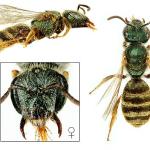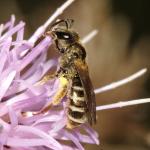Halictus constrictus (homonym) PROVANCHER 1882; Halictus provancheri DALLA TORRE, 1896; Halictus nearcticus VACHAL 1904; Halictus arapahonum COCKERELL 1906; Halictus (Chloralictus) olivarius SANDHOUSE 1924; Halictus flavipes auct. nec FABRICIUS
A rather small, metallic green bee, with white tomentose hair bands on the gaster. Great care must be taken, particularly with females, when separating this species from the common H. tumulorum. Best identified from the male, which should always be dissected to show the vital character in the genitalia.
A southern restricted species, recorded only from Dorset to Kent and north to West Norfolk. An Holarctic species, ranging from Spain and England to the far East of Russia but apparently not common; also found in North America. A variable species across its range with several listed infra-specific names.
Listed as Rare (RDB3) in both Shirt (1987) and Falk (1991).
Closely associated with sandy heath and other disturbed sandy situations, such as sand pits.
May to September, supported by few specimens (D W Baldock, pers. comm.).
A mining bee which is considered to be semi-social at least but possibly primitively eusocial, two or more females frequently sharing a nest.The nests are excavated in sparsely vegetated ground in warm, sunny situations. Pesenko et al. (2000) state that the nests are frequently constructed at the base of a plant or among the stems of a grass clump, rendering them difficult to locate.
In Britain, flower visits are known from bramble (Rubus fruticosus agg.), speedwell (Veronica sp.), yellow-flowered Asteraceae, creeping cinquefoil (Potentilla anserina), heather (Calluna vulgaris) and tormentil (Potentilla erecta). Some of these may represent pollen sources.
No cleptoparasitic bees are known to associate with this species.
Proofed: January 2012



